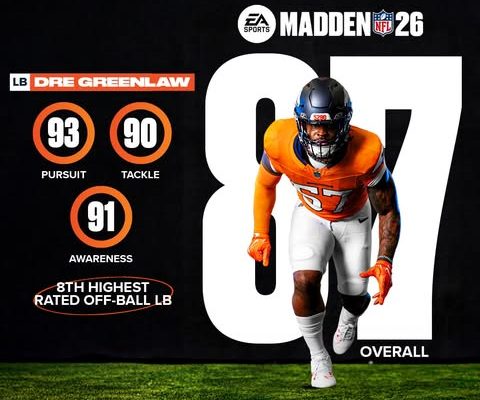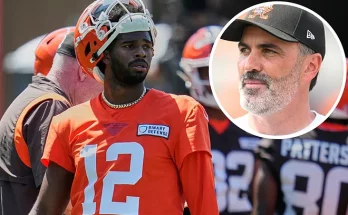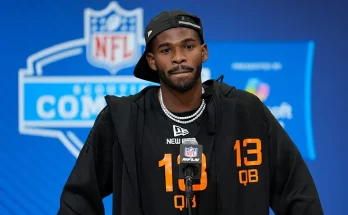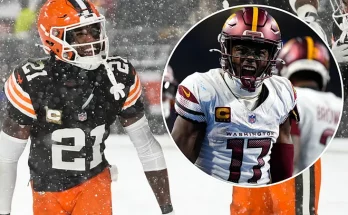BREAKING: Pat Surtain II, Quinn Meinerz, Dre Greenlaw, and Evan Engram All Crack Top 10 at Their Positions in EA Sports’ #Madden26 Rankings in a Bold Statement on NFL’s Underrated Elite
In a franchise that has long blurred the lines between reality and digital legend, the annual reveal of Madden NFL player ratings is a cultural moment as much as it is a gaming update. And in this year’s Madden 26 release, a surprising and well-deserved spotlight has been cast on four names who often don’t dominate mainstream headlines but have steadily made their case on the field: Pat Surtain II, Quinn Meinerz, Dre Greenlaw, and Evan Engram. In a move that caught fans and analysts off guard—in the best possible way—all four players landed inside the top 10 rankings at their respective positions, a monumental recognition of talent that often works behind the scenes or in the shadow of bigger market stars.
Let’s begin with Pat Surtain II. From the moment he entered the league out of Alabama, expectations were sky high for the Broncos’ defensive back. His father, a Pro Bowl cornerback in his own right, passed on the torch—and Pat Surtain II not only carried it but ignited a fire of his own. Known for his calm demeanor, clinical footwork, and ability to erase WR1s from the stat sheet, Surtain has quietly built a reputation as one of the most fundamentally sound corners in the NFL. Madden ratings have a tendency to reward flash more than substance, but this year, the developers gave credit where credit was due. Surtain’s blend of agility, play recognition, press coverage skills, and tackling earned him a top-10 spot among cornerbacks, and to many insiders, it’s a nod that’s overdue. His 2024 season was filled with lockdown moments against elite receivers, often with little fanfare, and Madden 26’s nod is a corrective measure for years of underrated excellence.
Then there’s Quinn Meinerz, a player who perfectly embodies the Madden franchise’s knack for uncovering cult heroes and turning them into virtual warriors. Hailing from the University of Wisconsin–Whitewater, Meinerz wasn’t expected to even sniff NFL starter status, much less top-10 recognition in the world’s biggest football simulation. But over the past two seasons, he’s become a mountain of a man on the Denver Broncos offensive line. With unmatched strength, sneaky agility for a player his size, and a motor that doesn’t quit, Meinerz has been a brick wall in pass protection and a bulldozer in the run game. His presence has elevated the Broncos’ offensive rhythm, giving quarterbacks time and running backs space—commodities that don’t show up in fantasy football stats but are vital to team success. Madden 26 clearly took note, rating him among the game’s best guards, and fans of trench warfare football couldn’t be happier. In an age where offensive linemen rarely receive their due, Meinerz’s top-10 placement is a breath of fresh Rocky Mountain air.
Across the conference in San Francisco, Dre Greenlaw’s story continues to evolve from promising to proven. When healthy, Greenlaw is the kind of linebacker every team wishes they had—ferocious, instinctive, and always around the football. The 49ers have built a defensive culture on toughness, precision, and accountability, and Greenlaw has been a critical part of that DNA. While Fred Warner often draws the headlines as the face of the linebacker corps, Greenlaw’s contributions are no less important. Whether it’s filling the gap on a 3rd-and-1 or chasing down tight ends and running backs in open space, Greenlaw plays with a tenacity that reflects the soul of his team. His Madden 26 top-10 rating at the linebacker position is both a recognition of his play and a rallying cry for those who appreciate substance over sizzle. It’s a declaration that hustle, heart, and consistent excellence matter—and matter enough to be rated right alongside the likes of Roquan Smith and Bobby Wagner.
Then we come to Evan Engram, whose journey is a study in resilience and reinvention. Drafted by the New York Giants with high expectations due to his rare blend of speed and size at the tight end position, Engram’s early career was plagued with drops and inconsistent usage. Critics wrote him off as a bust by the time his rookie contract was winding down. But a move to Jacksonville changed everything. In Doug Pederson’s creative offensive system, Engram has re-emerged as one of the most dangerous and dynamic pass-catching tight ends in the league. His chemistry with quarterback Trevor Lawrence blossomed in 2024, with Engram recording career highs in receptions and yards. He’s become a matchup nightmare—too fast for linebackers, too strong for safeties, and too clever for defensive coordinators. Madden 26’s rating team clearly saw the transformation, awarding him a top-10 spot among tight ends. It’s not just a numerical rating—it’s a statement that players can evolve, can rewrite their narratives, and can flourish when given the right tools and support.
What’s particularly interesting about these four players being rated in the top 10 at their positions is the broader conversation it invites about how we evaluate talent in the NFL and in video games. For too long, Madden ratings have sometimes relied on reputation or market size rather than consistent performance and true impact on the field. But with Surtain, Meinerz, Greenlaw, and Engram all earning these honors, it seems like EA Sports is signaling a shift—one where underappreciated impact is no longer ignored, and the complete football player is rewarded, even if they don’t dominate the highlight reels on national broadcasts every Sunday night.
Surtain’s inclusion reminds everyone that coverage skills and football IQ can define a secondary. Meinerz’s presence validates the belief that offensive linemen who grind tape and pancake defenders should be celebrated just as much as skill players. Greenlaw’s recognition affirms the value of linebackers who patrol the field with fearless efficiency, not just flashy sack totals. And Engram’s resurgence demonstrates that even in the age of high-octane passing, the tight end position remains one of the most versatile and vital cogs in a modern NFL offense.
From a Madden perspective, these ratings mean more than just how a player performs in Ultimate Team or Franchise Mode. They influence how fans around the world perceive these players. A young gamer in Berlin or São Paulo may not stay up late to watch a Broncos game or break down 49ers film, but they’ll know the name “Quinn Meinerz” or “Dre Greenlaw” because of the digital badge next to their name in the game. That exposure brings attention, and attention brings opportunity—endorsements, fan bases, and even Pro Bowl votes. It’s the Madden Effect, and it’s real.
It also brings into question the broader culture of NFL media recognition. Are we reaching a point where video games are becoming better barometers of player performance than talk shows or power rankings? While hyperbole should be avoided, it’s not unfair to suggest that Madden 26’s ratings—at least in these four cases—may be more accurate than the average pundit’s weekly top 10 lists. In the case of Surtain, for example, some fans have been begging for his elite status to be recognized for two seasons, and now a video game may have done more to cement that narrative than any ESPN segment.
Additionally, there’s a symbolic weight to this development. Each of these four players represents a different arc within the NFL. Surtain is the legacy—a second-generation pro who was groomed from Day One to become elite. Meinerz is the overlooked—an unheralded small-school prospect who beat the odds. Greenlaw is the grinder—a mid-round pick who built his value one tackle at a time. And Engram is the redemption—once doubted, now dominant. That’s the kind of narrative diversity that reflects the true spirit of the league. Not every player is a top-five pick or a combine hero. Some are craftsmen. Some are survivors. And some are phoenixes rising from the ashes of criticism. Madden 26, in its own way, captured that spirit this year.
Fans and analysts have responded positively, flooding social media with praise and surprise. “Finally, Meinerz getting the love he deserves,” one post read. “EA finally nailed the linebacker ratings—Greenlaw’s a beast,” said another. Engram’s fanbase, especially in Duval County, lit up Twitter and Instagram, calling his rating proof that Jacksonville’s resurgence is being taken seriously. And for Surtain, who has mostly operated in the quiet football wilderness of Denver, the attention is likely to only grow louder as national conversations catch up with his elite-level performance.
What remains to be seen is how this acknowledgment will influence the 2025 NFL season. Will these players use their Madden accolades as fuel for greater goals—Pro Bowls, All-Pro honors, playoff runs, Super Bowl glory? Or will the recognition serve as a sort of crowning moment in careers that have already defied expectations and rewritten narratives?
Either way, Madden 26’s decision to elevate Pat Surtain II, Quinn Meinerz, Dre Greenlaw, and Evan Engram into top-10 status is more than just a nod. It’s a shift. A digital declaration that consistent excellence, quiet leadership, and on-field results do matter. That greatness isn’t always loud—it’s often stoic, tireless, and built snap by snap. And now, thanks to one of the world’s most popular sports video games, the rest of the world is starting to notice.



